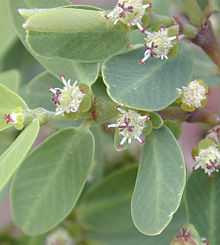Euphorbia celastroides
| Euphorbia celastroides | |
|---|---|
 | |
| Chamaesyce celastroides (inflorescence) | |
| Conservation status | |
| Not evaluated (IUCN 3.1) | |
| Scientific classification | |
| Kingdom: | Plantae |
| (unranked): | Angiosperms |
| (unranked): | Eudicots |
| (unranked): | Rosids |
| Order: | Malpighiales |
| Family: | Euphorbiaceae |
| Subfamily: | Euphorbioideae |
| Tribe: | Euphorbieae |
| Subtribe: | Euphorbiinae |
| Genus: | Euphorbia |
| Subgenus: | Chamaesyce |
| Species: | E. celastroides |
| Binomial name | |
| Euphorbia celastroides Boiss. | |
| Synonyms | |
|
Chamaesyce celastroides | |
Euphorbia celastroides, previously also known as Chamaesyce celastroides, named 'akoko by the Hawaiians, is a species of spurge closely related to the poinsettia.[1] This species develops into a round-shape shrub. This species is endemic to the Hawaiian Islands.
Description
E. celastroides grows as a medium-sized shrub or small tree reaching 2 metres (6.6 ft) in height.[2] To grow properly, this species requires temperatures of 15 °C (59 °F) and light shade.[3] This plant develops in a fashion similar to a shrub. In the summer, it assumes a red-violet colouring. It does not lose its leaves in the winter, due to the warm climate of its range. Female flowers have a three-part pistil over a three-part ovary, usually producing three (or sometimes more) seeds.[3] This species is tolerant of heat and drought. They are susceptible to fungal diseases. Its cyathia may be located in short or open-branched cymes, or remain ungrouped in leaf axils. The leaves are distichous (grow in two vertical rows) and may have a glaucous coating. This plant produces a green or brown, rounded fruit 2 to 4 mm long, containing grey-brown seeds 0.5 to 2.5 mm long.[2]
Distribution and habitat
Most varieties of this species can only be found in the Hawaiian Islands.[4][5] E. celastroides is tolerant of drought and grows in dry areas, inland as well coastal.[6] This species is endemic to the polihale and kanaio regions of Kauai and Maui.[7]
Conservation
E. celastroides has not yet been evaluated by the IUCN.[8] However, due to its endemic nature, it is very vulnerable to human threats. Two examples of such threats are four-wheeled vehicles (which crush the plant) and introduced species (which compete for resources).[7]
Varieties
This plant has many varieties. These varieties include:[9]
- Var. amplectens
- Var. halawana
- Var. hanapepensis
- Var. haupuana
- Var. humbertii
- Var. ingrata
- Var. kaenana
- Var. kohalana
- Var. laehiensis
- Var. laurifolia
- Var. mauiensis
- Var. nelsonii
- Var. nematopoda
- Var. niuensis
- Var. pseudoniuensis
- Var. saxicola
- Var. typica
- Var. waikoluensis
References
- ↑ Euphorbiaceae at hawaii.edu
- ↑ 2.0 2.1 Hawaiian flora at botany.si.edu
- ↑ 3.0 3.1 E. celastroides at ZipCodeZoo
- ↑ Wagner, W.; D. Herbst, S. Sohmer (1990). Manual of the flowering plants of Hawaii. Honolulu: University of Hawaii Press. p. 1853. ISBN 0-8248-1152-6.
- ↑ USDA.gov on Var.kaenana
- ↑ Mitchell, Andrew W. (1989). The fragile South Pacific: an ecological odyssey. Austin, TX: University of Texas Press. p. 167. ISBN 0-292-72466-7. Retrieved 5 October 2009.
- ↑ 7.0 7.1 CHAMAESYCE CELASTROIDES COASTAL DRY SHRUBLAND at hawaii.edu
- ↑ Chamaesyce celastroides at EOL.org
- ↑ Euphorbia on SageBud